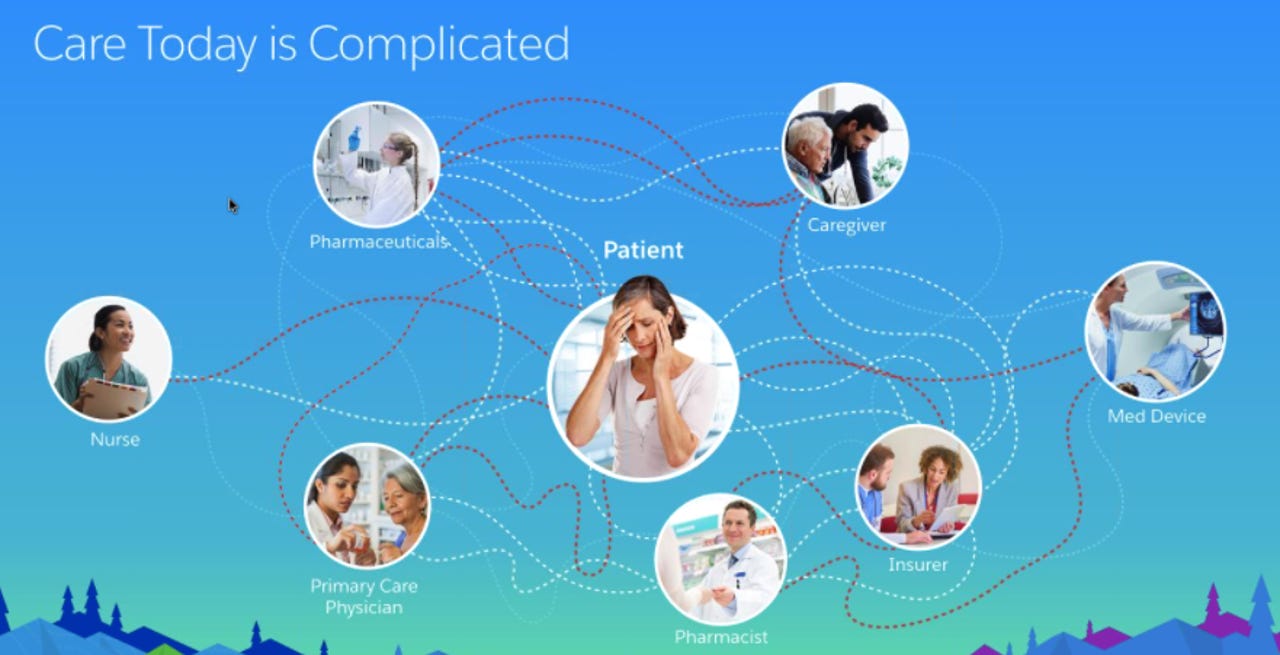Salesforce builds out ecosystem for Health Cloud, adds better patient targeting, risk scoring

Salesforce added risk segmenting tools, patient targeting and lead conversion data to its Health Cloud, an effort expand the company's footprint in an industry that accounts for 17.8 percent of U.S. Gross Domestic product.
That statistic, via the Centers for Medicare and Medicaid Services, highlights how Salesforce is going after large verticals. Typically, the company's offerings have been more horizontal with its Service Cloud, CRM and analytics tools. In some ways, Health Cloud is a bit of a departure for Salesforce, but the enterprise software vendor's bet is that healthcare is in dire need of modern customer relationship management.
At the Healthcare Information and Management Systems Society (HIMSS) Conference, Salesforce outlined Lead-to-Patient Conversion, Risk Stratification and Advanced Segmentation technology for the Health Cloud.
Joshua Newman, chief medical officer at Salesforce, said the lines between citizen, consumer, shopper and patient have merged. "Every industry is focusing more on customers and its' happening for patients. Making people happy with a better experience helps care," explained Newman.
Can Salesforce continually expand, become relationship operating system?
And on the other side of the health care equation, vendors need to better market to patients. "A decade ago even a bad doctor had a waiting list of customers and hospitals could easily generate revenue. Five years ago, we saw more health care organizations run like a business. And now you'll see large health care centers advertising to the community. It's a consumer brand issue," said Newman, who noted that Kaiser is marketing wellness to consumers and Geisinger Health System is offering money-back guarantees and leveraging technology to reach patients.

The Salesforce plan for Health Cloud will sound familiar to anyone who has tracked enterprise technology for the last 15 years or so. Salesforce enters market with a CRM approach and then creates an ecosystem to add functionality. Salesforce also notes that it won't compete with established transactional systems, but be a front end. Salesforce went after Oracle and IBM with this approach. In healthcare, Salesforce will note that it's not interested in being a electronic medical record provider like EPIC. Salesforce also won't get into medical procurement and billing processes in healthcare.
Nevertheless, Salesforce can become a bit disruptive to health care incumbents even though it's unclear how much traction Health Cloud has. The Health Cloud became generally available last February. Newman noted a lot of interest and innovative customers, but Salesforce hasn't talked up Health Cloud, which is about a year old, like it has its Analytics Cloud. At HIMSS, various Salesforce partners will demonstrate Health Cloud connections.
Salesforce has added a bevy of partners to its Health Cloud. Partner apps will be available via Salesforce's AppExchange. Partners range from wellness app maker Fitango to Healthwise to Sirano, a company that aims to make payment processes easier for patients.
Here's a look at the new features added to Salesforce's Health Cloud, which launched a year ago.
- Lead-to-Patient Conversion aims to create long-term relationships with patients by integrating leads from Salesforce Sales Cloud, Service Cloud and electronic health records. The tool will also import data from data warehouse, patient registration systems or call center. Health Cloud can use the data to map care plans and cut admin work. What's interesting here is that Salesforce is leveraging data in its other clouds to connect health care dots.
- Risk Stratification uses the Salesforce Analytics Cloud to give patients risk scores to enable providers to focus on high-risk groups. This risk-based approach is used to adjust reimbursements and screen a patient that needs a hip replacement but has six chronic conditions.
- Advanced Segmentation allows healthcare providers to filter patients using clinical and non-clinical data to reach groups.